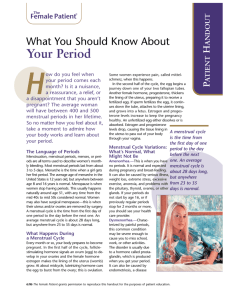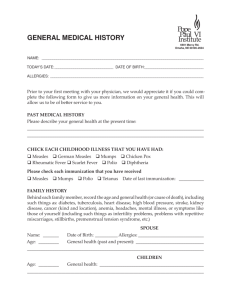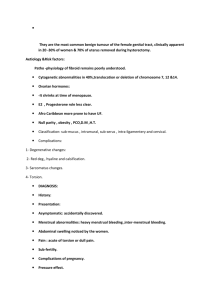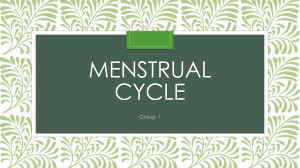Periods - Jean Hailes
advertisement
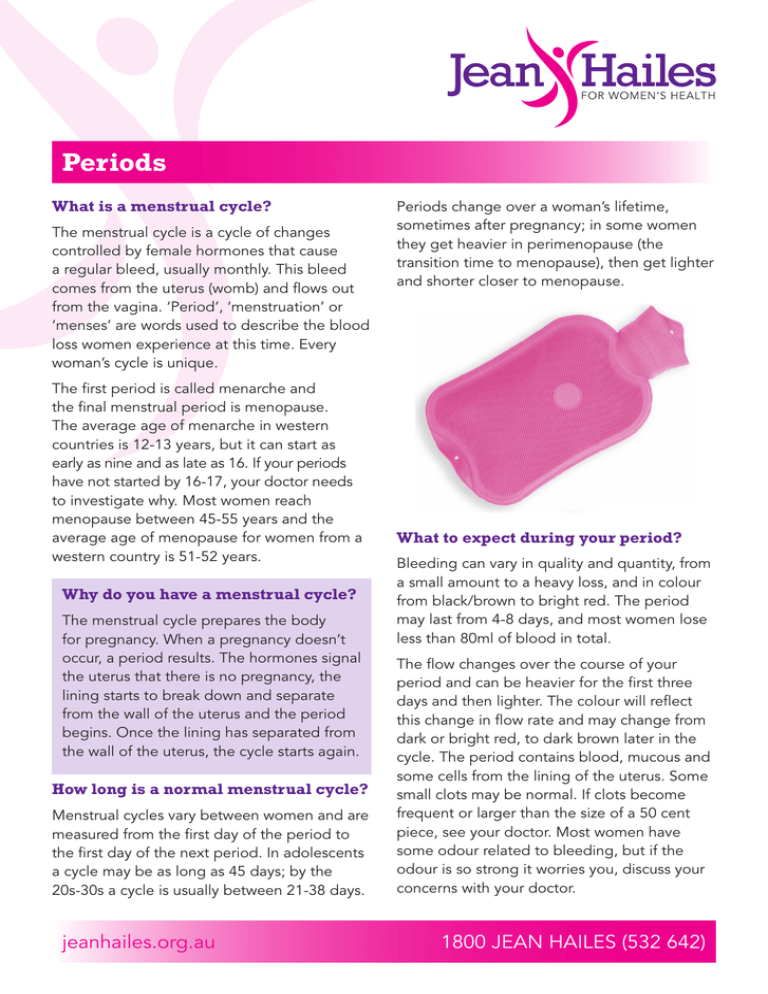
Periods What is a menstrual cycle? The menstrual cycle is a cycle of changes controlled by female hormones that cause a regular bleed, usually monthly. This bleed comes from the uterus (womb) and flows out from the vagina. ‘Period’, ‘menstruation’ or ‘menses’ are words used to describe the blood loss women experience at this time. Every woman’s cycle is unique. The first period is called menarche and the final menstrual period is menopause. The average age of menarche in western countries is 12-13 years, but it can start as early as nine and as late as 16. If your periods have not started by 16-17, your doctor needs to investigate why. Most women reach menopause between 45-55 years and the average age of menopause for women from a western country is 51-52 years. Why do you have a menstrual cycle? The menstrual cycle prepares the body for pregnancy. When a pregnancy doesn’t occur, a period results. The hormones signal the uterus that there is no pregnancy, the lining starts to break down and separate from the wall of the uterus and the period begins. Once the lining has separated from the wall of the uterus, the cycle starts again. How long is a normal menstrual cycle? Menstrual cycles vary between women and are measured from the first day of the period to the first day of the next period. In adolescents a cycle may be as long as 45 days; by the 20s-30s a cycle is usually between 21-38 days. jeanhailes.org.au Periods change over a woman’s lifetime, sometimes after pregnancy; in some women they get heavier in perimenopause (the transition time to menopause), then get lighter and shorter closer to menopause. What to expect during your period? Bleeding can vary in quality and quantity, from a small amount to a heavy loss, and in colour from black/brown to bright red. The period may last from 4-8 days, and most women lose less than 80ml of blood in total. The flow changes over the course of your period and can be heavier for the first three days and then lighter. The colour will reflect this change in flow rate and may change from dark or bright red, to dark brown later in the cycle. The period contains blood, mucous and some cells from the lining of the uterus. Some small clots may be normal. If clots become frequent or larger than the size of a 50 cent piece, see your doctor. Most women have some odour related to bleeding, but if the odour is so strong it worries you, discuss your concerns with your doctor. 1800 JEAN HAILES (532 642) Premenstrual syndrome (PMS) Period pain Premenstrual symptoms including irritability, bloating, pimples and tiredness, may occur in the 1-2 weeks before your period. Normally these symptoms might be annoying but would not interfere significantly with day to day activities. Around 2/3 of women experience some breast pain during their cycle and most have 1-2 premenstrual symptoms that can be managed. Symptoms start about 4-10 days before a period and usually stop after bleeding begins. Symptoms appear to peak in adolescence and again in perimenopause, possibly because of fluctuating hormone levels. Period pain happens when the muscles in the uterus contract or tighten. Pain may include cramping and heaviness in the pelvic area, as well as pain in the lower back, stomach or even legs. Women who experience painful periods may have higher levels of prostaglandins – a natural body chemical that causes contractions of the uterus, bowel and blood vessels. Period pain should only be considered ‘normal’ if: Premenstrual dysphoric disorder (PMDD) is a more serious form of PMS, where severe symptoms significantly interfere with daily living. If the pain is not like this, it is not normal. On average, a woman in Australia has 450-500 periods in her lifetime. What is heavy bleeding? Heavy menstrual bleeding (menorrhagia) is excessive and/or prolonged menstrual bleeding. The amount varies from woman to woman and can change at different life stages, for example, approaching menopause. It is defined as blood loss greater than 80ml per cycle or periods lasting more than 7-8 days. • it is only there on the first 1 or 2 days • goes away if you use the contraceptive pill or take period pain medications • your ability to do your normal activities is not impaired When to see your doctor • Changes in the pattern of your period • Increasingly heavy periods • Long period of more than 8 days • Periods that come every 21 days or less • Periods that come more than 2-3 months apart • Painful periods causing you to stay home • Bleeding between periods • Bleeding after intercourse For more information go to jeanhailes.org.au/health-a-z/periods Periods fact sheet - Updated April 2014 This fact sheet is designed to be informative and educational. It is not intended to provide specific medical advice or replace advice from your medical practitioner. Jean Hailes for Women’s Health gratefully acknowledges the support of the Australian Government.

